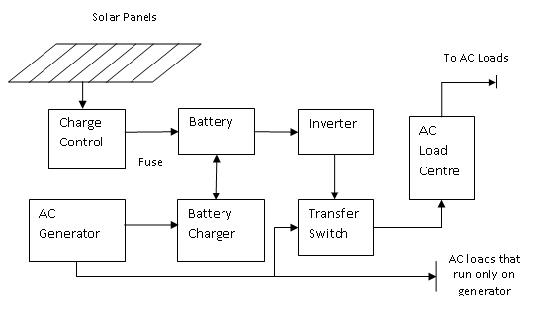Within this section you will find
Stand Alone PV Systems/Small Rooftop Packs
Standalone systems are designed to operate independent of the grid, these systems sync with a diesel generator and/or batteries. Battery based systems used to be of smaller capacity due to the cost involved, but the rising cost of other power sources, and the lack of power at any cost has seen a steady increase in battery based system sizes
[showad block=2]
Grid-tied Rooftop Solar Power
These systems are designed to work with the grid alone. Thus, it is a combination of solar PV and grid.
As these systems depend on the reference voltage provided by the grid for their operations, grid-tied systems do not work when the grid is down.
Hybrid Systems
Hybrid systems can sync with multiple sources of power. While a diesel generator is the most common other source of power, attempts have been made to sync solar with wind and biomass gasification as well.
|
Other than diesel hybrids, the other systems are still in relatively early stages of development and
Diesel-Solar hybrids are very popular with heavy diesel consumers as diesel power is much more expensive than solar power, and the solar plant can help reduce expenditure on diesel. Solar plant sizing, however, is critical in these applications – the capacity of the solar plant should be less than a third of the capacity of the diesel generator (when a single diesel generator is used) to avoid reverse current flow into the DG or preventing the load on the DG from falling below the DGs most efficient load range.
Rooftop Solar Segments
Residential Rooftops
Rooftop solar plants on residences are the same as the plants meant for industrial and commercial applications except that they are usually smaller due to the lower energy consumption of a residence.
Commercial Rooftops
An off-grid rooftop solar plant may not be able to power heavy loads such as air-conditioning or elevators, but a battery based plant can power most office equipment and lighting.
Retail facilities and warehouses usually have large flat roofs and heavy energy consumption, making them ideally suited for rooftop solar plants, especially when paired with a diesel generator.
Many energy consumers are also going towards captive solar plants for on-site generation of electricity. These industries include:
- Textiles
- Cement
- Chemical
- Iron & Steel
- Light Engineering
- Ceramic industry
- Paper
- Sugar industry
- Dairy
[showad block=3]
Consumersof Rooftop Solar Power
- Industrial/Commercial Segment
- Residential Segment
Industrial/Energy Consumers
This category of consumers are likely to be charged higher grid tariff and/or are likely to generate power from diesel, and can claim depreciation against profits.
- A commercial consumer in Mumbai consuming greater than 500 kWh of grid power in a billing cycle will pay Rs. 11.91/kWh which is much more expensive than rooftop solar power
Residential Consumers
These consumers typically pay a lower tariff for grid power than industrial/commercial consumers, are less likely to consume significant quantities of diesel for power generation, and cannot claim depreciation as they don’t generate profits.
- An LT I Residential Consumer in Mumbai consuming less than 100 kWh in a billing cycle will pay Rs. 3/kWh (drawing from BEST utility) which is cheaper than the cost of rooftop solar power
Despite the above, it should be noted that some residential consumers may benefit from rooftop solar power depending on the quantum of power consumed.
Related Article
1. Key Drivers for Rooftop solar Power in India
2. Major Challenges for Rooftop Solar Power Plants in India
3. Attractive Segments and Innovations in Rooftop Solar Sector
4. Solar Thermal – Products and its Market Status
5. Solar Off-Grid Applications and Products
 Skip to content
Skip to content

